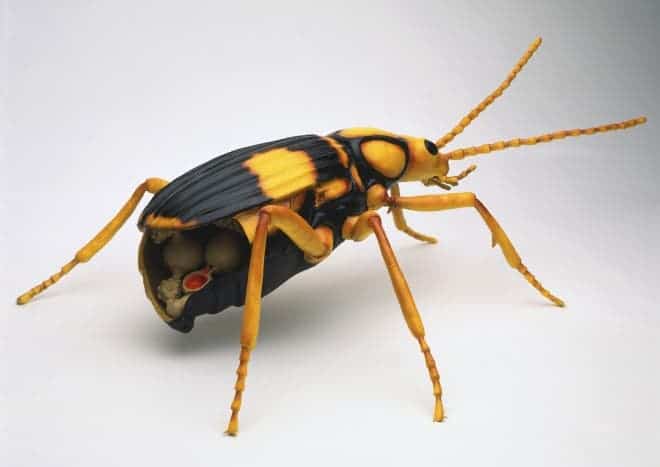Animals have evolved all sorts of gimmicks for either attack or defence. Some are really over the top, but that doesn’t make it less effective. Take the bombardier beetle, for instance, which sprays a deadly mix of boiling chemicals from its butt. This is one insect you don’t want to mess with.
Inside the bombardier’s abdomen is a blast chamber where two chemicals, hydrogen peroxide and hydroquinones, react to form a superheated spray called benzoquinone. These two chemicals sit idly most of the time, but when the bug feels threatened it releases a catalyst that sets off the benzoquinone reaction.
This mixture explodes from the beetle’s hind like a lawn spray, instead of a streamlined jet, spewing the boiling chemicals in virtually all directions at a rate of 500 to 1000 squirts/second. The heat is enough to kill smaller threats like ants, and can scare away anything bigger from amphibians to humans.
“You’ve got 100 degrees centigrade temperature, you’ve got a chemical burn, the steam comes off like a smoke, and then also the reaction kind of hisses,” said entomologist Terry Erwin of the Smithsonian Institute. “There might be 200 of these beetles under one rock, and they all fire at the same time, and you’ve got a smokescreen, or vaporscreen, as it were,” Erwin said.
Once the pressure is released via the expulsion of the newly created benzoquinone, the valve opens once more, allowing for the next explosion. In a good day, the bombardier beetle can fire up to 20 times before running out of ammo.

Since the spray is pulsed, the blast chamber has enough time to cool and prevent overheating that might damage the beetle. Its first line of defence, however, is the blast chamber itself whose walls are very dense. Moreover, once the cannon is ready to fire all of the reacted mixture is expelled.
This sophisticated adaptation is certainly fascinating, and a prime example of how ingenious evolution’s solutions can be. There are even practical benefits to observing the bombardier beetle. Researchers at MIT are closely following the beetle and hope their work might lead to better blast protection systems, and even the creation of new types of propulsion systems.
Was this helpful?




